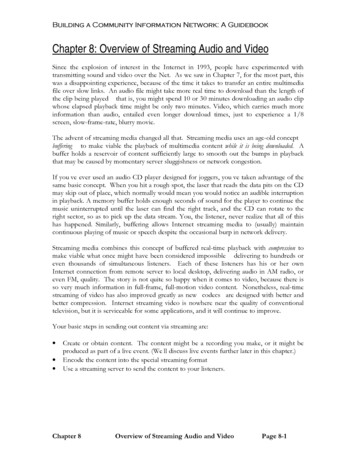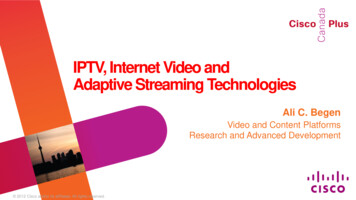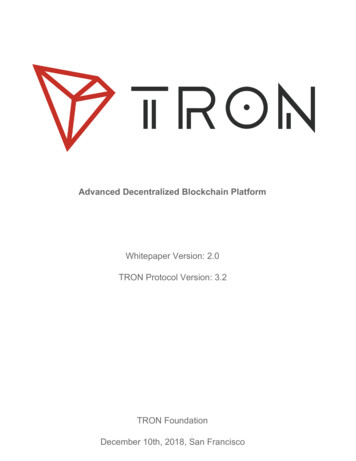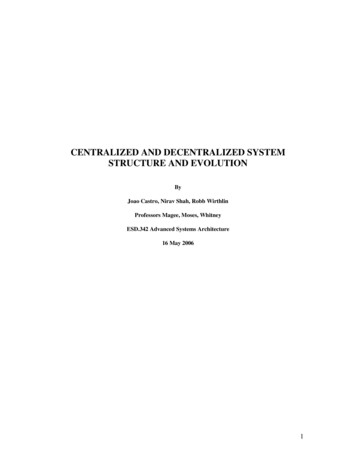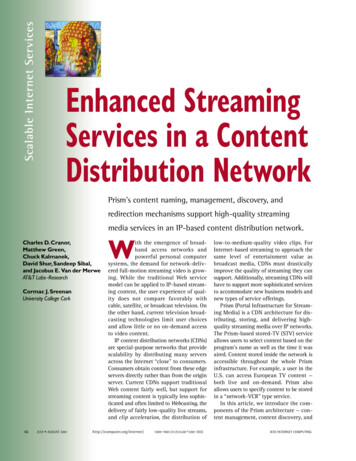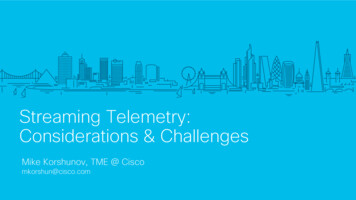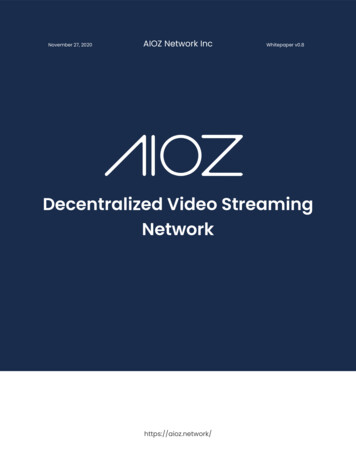
Transcription
1AIOZ Video Streaming NetworkNovember 27, 2020AIOZ Network IncWhitepaper v0.8Decentralized Video StreamingNetworkhttps://aioz.network/
vCopyright 2020 AIOZ, Inc. and SubsidiariesThis work is licensed under a Creative Commons Attribution-ShareAlike 3.0 license (CC BY-SA 3.0).All product names, logos, and brands used or cited in this document are property of their respective owners.All company, product, and service names used herein are for identification purposes only.Use of these names, logos, and brands does not imply endorsement.
A. BACKGROUND.4VIDEO STREAMING AND ITS EVELOPMENT.4CENTRALIZED AND DECENTRALIZED NETWORKS.6B. AIOZ STREAMING NETWORK.9AIOZ NETWORK ARCHITECTURE.91. AIOZ Worker Node.92. AIOZ HUB Node.10AIOZ NETWORK OPERATION.111. System Workflow Overview.112. Proof of Transcoding.133. Proof of Storage.164. Proof of Delivery.18BENEFITS OF AIOZ CDN. 20C.AIOZ BLOCKCHAIN NETWORK. 21Byzantine Fault Tolerance.21AIOZ dBFT. 22D. D-APPS ON TOP OF AIOZ STREAMING NETWORK. 24CONTENTSE. FUTURE WORK. 26
A. BACKGROUNDVIDEO STREAMING AND ITS DEVELOPMENTIn today’s technological era, streaming, which is deemed an outstanding innovative technology,has become a norm to almost all people worldwide, both professionally and personally. For those whoare confused with what ‘streaming’ really is, it is simply the activity of listening to or watching soundsor video directly from the Internet. Thanks to the streaming revolution, people can gain access tonumerous online resources for entertaining at any time and from anywhere, with any devices as longas they have an Internet connection. Moreover, streaming technology enables people to overcomebarriers in terms of geographical distance to build more connections as well as to widen their horizons.Chronologically, it is the music industry that streaming started with, then it has been transferring tomovies, technologies and video games and, in the near future, VR and AR would be the following items.At the present time, ‘video streaming’ is the most popular area after witnessing a phenomenal growthin recent years.It is true that video streaming technology has nearly beaten obsolete broadcasting technologiessuch as cable and satellite because it offers viewers more significant benefits compared to traditionalbroadcasting services. For instance: video streaming provides people with a more diverse source ofcontent; video streaming could be conducted on any electronic devices; we could enjoy high-qualityvideos whenever we want by streaming, and most importantly, through video streaming, anyone of uscould become a content creator and earn more income. As per the ‘2019 Global Internet PhenomenaReport’, video streaming accounts for the highest percentage of total global internet traffic, with thefigures for 2018 and 2019 were 57.7% and 60.6%, respectively. According to the latest statistics, video isforecasted to account for 82% of total internet traffic by 2022. Meanwhile, revenue obtained from videostreaming witnessed a continuous increase from 2017 to 2020 and is expected to reach US 28,1 billionby 2023.
5AIOZ Video Streaming NetworkSuch rapid development of the video streaming market has led to anincrease in the number of video streaming services. So far, a plurality of theavailable video streaming platforms, including the most popular ones suchas Youtube, Netflix, Hulu, Twitch, are supported by only three predominantcentralized content delivery networks* (CDN), which are CloudFlare, AmazonWeb Services, Akamai. This imbalance makes the global demand for CDNshas risen exponentially within recent years.CDN is a highly-distributed platform of servers of which purpose is to provide fastercontent delivery with minimal delays in loading web page content by reducingphysical geographical obstacles between servers and users.Figure. Model of a typical CDN
6AIOZ Video Streaming NetworkCENTRALIZED AND DECENTRALIZED NETWORKSCentralized network is built around a single server which is called a ‘Central server’,and a number of less powerful workstations (‘Client nodes’) directly connecting to theCentral server. In such systems, Client nodes will send their requests to the Centralserver (the place performs all the core processing) - and receive the response.Decentralized network, on the other hand, is operated by several individual nodeswithout depending on a single central server. The final response is the total of thedecisions of the individual nodes on processing requests.CentralizedDecentralizedUp to the present, conventional centralized networks are the major systems supporting streamingservices globally due to their consistency and efficiency. Nonetheless, within the context that more andmore video streaming platforms have been launching (demand increases), while owing to tremendousexpenses on construction, operating and maintenance, only a small number of prestigious corporationssuch as Amazon Web Services, Microsoft and Google Cloud are wealthy enough to develop their owncentralized network infrastructure (limited supply), the pros of centralized network systems have beenprogressively outweighed by cons. Main disadvantages of centralized network are as follows:Centralized networks can be censored, controlled, or even shut down.In more detail, if the only central server were attacked by hackers, enterprisesor governments AND/OR if client nodes lose connectivity due to some uniquetechnical errors, abrupt failure of the entire system might take place.Centralized networks have limited scaling possibilities.It is because these types of networks operate with 100% dependence onthe only master server. The only way to scale the network is to supplement theserver with more CPU/GPU cycles for more processing power, more space forstorage and more Internet bandwidth. Nevertheless, after a certain threshold,even if you increase the resources of the server node, the performance willnot rise correspondingly. As a result, this is not a cost effective measure inthe long run.The operation around only a single master can soon result in abottleneck effect
AIOZ Video Streaming Network7especially within the context that the streaming services have beendeveloping at a phenomenal rate. As a result, users’ experience on theseservices could be negatively impacted (e.g. poor video quality, slow loading,buffering problem). Without a doubt, negative feedback from users is notwhat businesses expectCentralized networks offer less possibility of data backup.If the server node fails and there is no backup, data is lost straight awayPrices of services of centralized systems are high.Consequently, it might take clients a long time to turn a profit as amajority of their revenue is paid to corporations that provide cloud services.In addition, the revenue of content creators/streamers would significantlyreduce as well. A clear illustration for the main disadvantage in terms of highcost is Youtube - the most popular streaming platform at present.Decentralized networks, by contrast, can fix all aforementioned issues and also offer a great deal ofadvantages over the traditional centralized network systems. Here are some benefits of decentralization:There is no real single point of failure.This is attributable to the fact that in decentralized networks, individualnodes work independently whereas there is no single ‘Central server’ tocontrol and handle all processes. As a result, it is impossible to shut downthe entire network.Decentralized networks can be infinitely scaled.The more individual nodes are added to the network, the more powerfulthe network would be because a lot of new connections would be establishedand the aggregate of resources including spare processor cycles, storage,Internet bandwidth would remarkably increase. Therefore, the probabilitythat bottlenecks happen is extremely low.Decentralized networks architecture offers higher privacy for users,as all information is processed by a well-designed algorithm without theneed to pass it to any third parties. This makes decentralized networks highlycensorship-resistant and and more secure against cyberattacks.More autonomy and control over resources.As each node controls its own behavior, it will have better autonomy whichleads to more control over resources.Censorship is less likely to take place.It is more and more popular that governments shut down their citizens’access to social media sites due to some political reasons. All governmentshave to do is stop traffic going to the social media’s central servers. By contrast,it is genuinely difficult for them to censor traffic on a peer to peer network,where every single outbound packet being sent could be communicatingwith another peer on the decentralized network, who can then forward thatmessage along.
AIOZ Video Streaming Network8There is potential for network ownership alignment.In decentralized networks, the people who contribute value will receiveownership or economic stake in the network, which becomes more valuableas the network grows.Decentralized networks are more likely to be open development platforms.This means that anyone can build their own tools, products, and serviceson top of decentralized networks. When more great products and tools arebuilt, the networks will be rapidly widened, and thus business opportunitiesprovided for individuals and companies will rise correspondingly.Thanks to these various benefits, especially the cost advantage, decentralized networks haveincreasingly come to a lot of video streaming platforms/applications providers’ knowledge. More andmore video streaming platforms/applications have been developed and run on a decentralized peerto-peer network instead of conventional centralized servers. Such platforms/applications are knownas ‘Decentralized Applications’ or as ‘DApps’. Currently, Dapps are still in their infancy, with more than3000 Dapps built on Ethereum. Nevertheless, they are forecasted to grow exponentially, with the marketsize being projected to reach USD 21,070.2 million by the end of 2025 - as per a study carried out bythe Blockchain Examiner. The growth of Dapps will definitely give rise to the expansion of decentralizednetworks in the future.
B. AIOZ STREAMING NETWORKAIOZ NETWORK ARCHITECTURE‘AIOZ CDN’ is a decentralized peer-to-peer CDN built from the connection of different nodes by apre-designed protocol of AIOZ team. Nodes in AIOZ CDN are categorized into HUB Node (a.k.a SatelliteNode) and Worker Node.AIOZ NETWORK OVERVIEWAIOZ Worker NodeWorker Nodes are individual nodes with redundant resources andthus, they want to share these resources in exchange for AIOZ tokens. Themonetization process will be determined based on two facets including thelevel of contribution and their commitment to our protocol. Worker Nodesare allowed to choose whichever HUB Node possessing high credibility towork with, and notably, they can select as many HUB Nodes as they wantto gain more income sources. However, if Worker Nodes are detected to be
AIOZ Video Streaming Networknon-compliant with requirements listed in the contract by HUB Nodes, thenbased on the nature and levels of violation, their payments will be cut downpartially/fully, or they can be permanently eliminated from AIOZ CDN.By installing AIOZ Worker Node Software, any PCs and laptops can becomeWorker Nodes of AIOZ CDN. Worker Nodes can opt for more than one task tohandle among transcoding, storing and delivering.There are a lot of aspects that must be taken into consideration whenselecting which worker nodes are suitable to store data, including: pingtime, latency, throughput, bandwidth caps, sucient disk space, geographiclocation, uptime, history of responding accurately to audits, and so on. Inaddition, these nodes can be configured maximum allowed disk space andbandwidth usage by HUB Nodes. In particular, they will be monitored howmuch both of these resources remain whereas their invalid operations willbe rejec
3. Proof of Storage. 4. Proof of Delivery. 4 9 21 20 22 6 11 11 9 13 10 16 18. In today’s technological era, streaming, which is deemed an outstanding innovative technology, has become a norm to almost all people worldwide, both professionally and personally. For those who are confused with what ‘streaming’ really is, it is simply the activity of listening to or watching sounds .
